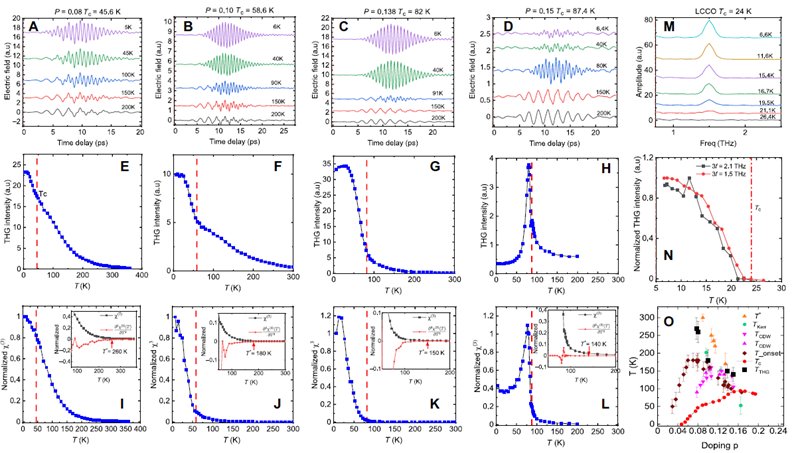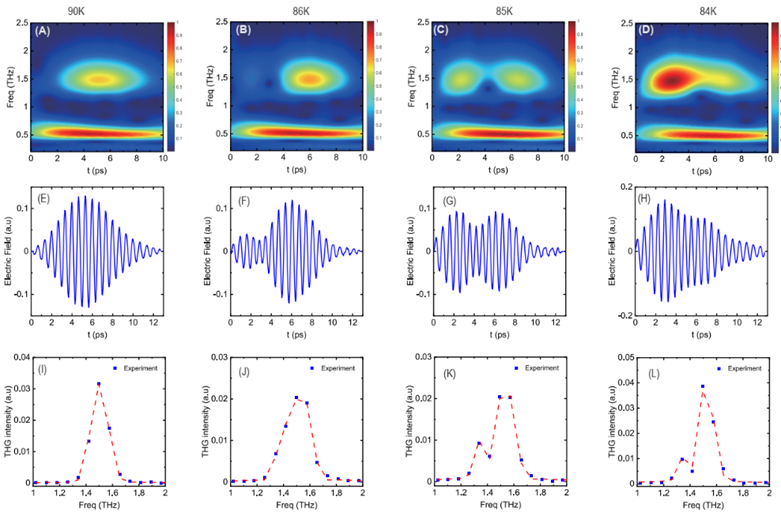Prof. Nanlin Wang's research group and their collaborators report detection of the Higgs mode in high-temperature superconductor and its coupling effect with collective mode in the pseudogap phase
2024/03/06
Professor Nanlin Wang’s research group at Peking university/BAQIS and their collaborators employed the strong-field terahertz third-harmonic generation technique to investigate the coupling between the Higgs mode in the superconducting state and the collective mode in the pseudogap phase of the YBa2Cu3O6+x (YBCO) superconductor. Their study unveiled compelling evidence of dynamical interaction between the order parameters of the superconducting state and the pseudogap state in high-temperature superconductors. This research provides valuable experimental insights into understanding the nature of the pseudogap phase and its interplay with the superconducting state. The research findings were published online recently in Science Advances, 2024.
High-temperature superconductivity has been a focus in condensed matter physics research since its discovery in 1986. However, the mechanism underlying high-temperature superconductivity and associated anomalous metal properties remain unresolved, with no consensus reached. A range of spectroscopic techniques, including scanning tunneling spectroscopy, angle-resolved photoemission spectroscopy, infrared spectroscopy, and nuclear magnetic resonance (NMR), along with diverse electron transport measurements, have indicated the presence of energy gap (pseudogap) well above the superconducting transition temperature. Despite over three decades of investigation, the relation between pseudogap and superconductivity remains unresolved. One perspective suggests that at the onset temperature of the pseudogap phase, electron pairing begins to commence, yet these pre-formed pairs do not establish long-range coherence. In contrast, an alternative viewpoint posits that the pseudogap phase represents a distinct state of matter independent of or competing with superconductivity. Elucidating the relationship and interplay between the pseudogap and superconductivity stands as a crucial advancement in comprehending the origin of cuprate superconductivity. It is important to note that these spectroscopic and transport measurements detect the single-particle excitation responses and behaviors within the material.
In superconductors, besides the single-particle excitations, there exists collective modes. In general, the spontaneous breaking of continuous symmetry leads to the presence of gapless collective mode, known as Nambu-Goldstone mode. The superconducting condensation breaks the global U(1) symmetry, leading to a fixed phase in the order parameter. Because of the gauge invariance of the electromagnetic field, the zero-energy phase mode is absorbed into the longitudinal component of the electromagnetic field, pushing its energy up to the plasma frequency at very high energy scale, which is acknowledged as the Anderson-Higgs mechanism in superconductor, which underlies the complete diamagnetism or Meissner effect observed in superconductor. The sole collective excitation present in superconducting condensation is the Higgs amplitude mode, with an energy precisely double the superconducting energy gap in the long wave limit. The Higgs mode carries no charge, spin, electric dipole moment, and magnetic dipole moment, and it does not interact with the electromagnetic field within the linear response range. Detecting the Higgs mode through conventional electromagnetic response techniques is challenging, except in specific material systems that coexist with charge density waves. Furthermore, the energy scale of the energy gap in superconductors is typically very low, necessitating excitation energy scales below the superconducting energy gap, typically in the meV energy range. Recent advancements in pulse laser technology have enabled the generation of strong field terahertz pulse, facilitating the detection of the Higgs modes in superconductors. Theoretical and experimental studies have shown that, during the driving period of terahertz pulse, the nonlinear coupling between the Higgs mode and the terahertz electric field can produce terahertz third harmonic generation signals. Resonance enhancement occurs when the energy of the driving terahertz matches that of the Higgs mode. Through the direct detection of the collective mode of superconductivity order parameters in cuprate superconductors, it is anticipated that novel insights can be offered regarding the understanding of superconductivity in these materials and their correlation and interplay with pseudogaps.
The earlier detection of Higgs modes in conventional superconductors MgB2 (Phys. Rev. B 104, L140505 (2021)) and NbN (Phys. Rev. B 105, L100508 (2022) prompted Wang Nanlin's research group to conduct systematic strong field terahertz driving experiments on YBa2Cu3O6+x samples with varying doping levels. The group observed distinct terahertz third harmonic signals compared to those found in conventional superconductors: (1) The terahertz third harmonic generation signal emerges in the normal state, with its appearance temperature increasing consistently as doping concentration decreases. This behavior aligns with the onset of pseudogap temperature in the phase diagram of cuprate superconductors, as depicted in Figure 1. (2) In the optimally doped sample, anomalies in the terahertz third harmonic signal manifest near the superconducting transition temperature (Tc) as temperature decreases, accompanied by beat pattern in the time-domain spectrum. The Fourier-transformed frequency domain spectrum reveals two split peaks flanking the original third harmonic peak, a feature that diminishes with further temperature reduction, as illustrated in Figure 2. (3) Below Tc, the terahertz third harmonic signal exhibits a peak, indicating presence of resonance enhancement. However, with further under-doping, these anomalies gradually fade, leading to a monotonic increase in signal with decreasing temperature. (4) As a comparison, terahertz driving experiment on an electron-doped cuprate superconductor lacking pseudogap phase demonstrates that the third harmonic generation signal only emerges below the superconducting temperature.
The experimental findings presented above offer novel insights into the identification of collective modes in superconductors and the elucidation of the relationship between pseudogap and superconducting gap in high-temperature superconductors. In the underdoped system, no anomalies were observed in terahertz third harmonic generation at Tc, a phenomenon that seems to be explained by the preformed Cooper pairs. However, in the optimally doped sample, the terahertz third harmonic generation signal exhibited a beat pattern when the temperature drops below Tc, suggesting the emergence of an additional mode of generating the third harmonic signal below Tc during the driving experiment. While it was anticipated to manifest at the third harmonic position of the fundamental frequency, an interaction between the two signals causes their energy to split, resulting in their appearance on either side of the original third harmonic energy position. This outcome suggests distinct origins for the pseudogap and superconducting energy gap, particularly in the optimally doped sample. While the signal observed below Tc is attributed to the Higgs mode of superconductivity, the third harmonic generation contribution in the normal state likely corresponds to a mode from different ordered state. Further comprehensive investigation into its origin is necessary.
Jiayu Yuan, a doctoral student of Nanlin Wang’s group at the Quantum Materials Science Center in the School of Physics at Peking University, is the first author of the paper. Co-corresponding authors were Research Associate Professor Tao Dong and Professor Nanlin Wang. Researchers Li Yue, Bohan Li, and Dong Wu in BAQIS contributed to measurements. The high-quality YBCO films with varying doping levels utilized in this study were supplied by the research team led by Academician Zizhao Gan and Associate Professor Yue Wang from the School of Physics. Additionally, samples of optimally doped YBCO films and electronically doped LCCO films were provided by the research team led by Kui Jin, a researcher at the Institute of Physics, Chinese Academy of Sciences. Funding for this research was provided by the National Natural Science Foundation of China, the National Key Research and Development Program, and the Quantum Matter Science Collaborative Innovation Center.
Article Link: https://www.science.org/doi/10.1126/sciadv.adg9211.

Figure 1: Terahertz third harmonic generation spectroscopy measurements of YBCO thin film samples with varying doping levels and LCCO thin film sample at optimal doping. The characteristic temperature TTHG, as defined by the terahertz third harmonic generation signal, aligns with the trend of the pseudogap temperature T* across a broad doping range.

Figure 2: The terahertz driving experiment conducted on an optimally doped YBCO superconductor with Tc=87 K, using a fundamental frequency driving pulse energy of 0.5 THz. Panels (A) to (D) present the time-frequency analysis of the strong terahertz field passing through the sample. Panels (E) to (H) demonstrate the digital filtering of signals above 1 THz, revealing that as temperature decreases, the third harmonic generation signal below Tc exhibits beat phenomena in time domain, which diminish at lower temperatures. Panel (I) to (L) displays the Fourier transform of (E) to (H), showing emergence of energy splitting in frequency domain near Tc.
 中文
中文 Email
Email QCloud
QCloud Log in
Log in
